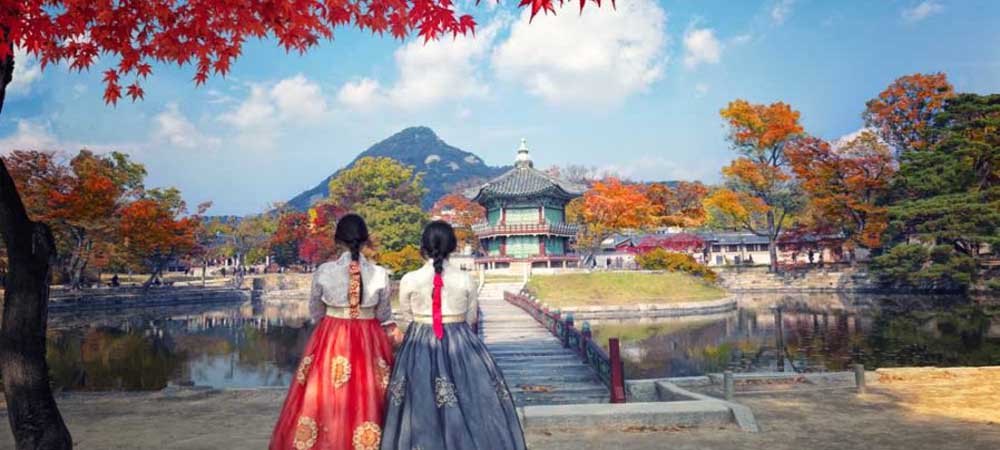South Korea is a beautiful and unique peninsular country, sandwiched between the mainland of China and Japan with coasts bordering the Yellow Sea and the Sea of Japan. The northern border which it shares with North Korea is one of the most militarized borders in the world, erected following peace agreements in 1953. The countryside is a beautiful blend of rich nature and ancient temples, featuring cherry trees amid sometimes rolling hills and small villages well worth exploring for a look at everyday Korean life.
The country itself is a unique blend of history and tradition meets modern development. While the countryside is home to centuries-old temples, the capital Seoul has its eye on the future with impressive, almost futuristic buildings and technology, offering a unique look into the industrial advancements that the country has made over the last few decades, keeping up with its neighbor Japan in terms of things like robotics, technology, and engineering.
Visiting Korea with Explorient on one of our amazing Korean tours can be one of the best experiences of your Asian adventures. Indeed, traveling to Korea will showcase a country that has overcome a number of problems associated with the Korean War to become the bustling, welcoming and beautiful country it is today. If you’re planning a trip to South Korea sometime soon, you may be interested to learn about some of the points of tradition and etiquette that you will want to try and follow to ensure you have one of the best travel experiences of your life. In truth, when traveling, following the etiquette of the locals can help create a much more enriching experience for visitors, helping to give them an experience they will remember for years to come.
If learning about the etiquette and culture of South Korea is something you like the sound of, we’ve put together this useful etiquette guide to help prepare you for some of the different traditions and customs you might experience when you’re in this wonderful country.
South Korea – A Colorful and Welcoming Place
As with all countries, South Korea has a whole host of different customs and traditions that visitors should be made aware of. Here are just some of the most common points of etiquette and tradition that you may encounter on your Seoul Stopover with Explorient.
Kibun
Kibun – a word with no direct English translation. The general idea of kibun is someone’s individual wellness, their pride or their sense of worth. This can be directly compared to the South East Asian concept of ‘face’ and ‘saving, building or giving face’. Someone’s kibun is an important aspect of their life and it should be regarded as an important factor in a westerner’s behaviors when in Korea to ensure that you don’t directly or indirectly harm someone’s kibun – including your own! In Korea however, there is another aspect to kibun, which is known as nunchi. This is essentially watching and listening for social cues to help determine a person’s state of mind and how they are feeling and then directing your action based on their nunchi.
Ways to help avoid harming a person’s kibun include: being discreet about issues that arise, not making a scene when a product or service is not to your standard, and generally behaving in a courteous, understanding manner.
Harmonious Associations
Harmony is respected, almost above all, in social interactions in South Korea. This means that you should take care not to disrupt the harmonious balance in social situations and in public, even if you have to tell a small lie to keep the peace. People in South Korea prefer to keep any potential issues at bay, and it’s appreciated if you endeavor to do the same.
Bowing
Like neighboring Japan, bowing in greeting and departure is par for the course in South Korea. Men will bow to other men, sometimes with a handshake involved. When shaking hands with people in South Korea, your left hand should support your right arm, essentially shaking with both hands indirectly. Women will bow, but often their bow will be more of a nod of the head. The depth of the bow indicates formality and levels of respect – a very deep bow is typically reserved for those who are greatly respected, however, it is not uncommon to receive a very deep bow from a local as a foreigner. You should always bow to someone when departing. You’ll get lots of practice bowing in South Korea on your Gyeongju and Busan tour.
Declining, The Word No and Generally Disagreeing
To decline something, use the word no and generally disagree with a stated fact or opinion in South Korea is seen to be disharmonious and generally avoided. Some communications may be prolonged due to a person trying to avoid disagreeing outright and thus ‘beating around the bush’ to arrive at an understanding where they are able to disagree without disagreeing. People will frequently try to avoid using the word no, as it’s seen as rude, so don’t be surprised if your South Korean hosts use long-winded explanations for things where they may not be able to provide a service or product that’s been requested. Practice this skill in advance of your trip to Korea on your Seoul Stopover with Explorient.
Personal Space
Personal space is highly respected in South Korea. Care should be taken not to overly use one’s hands in conversation, potentially disrupting someone else’s space. Likewise, you should not touch or hug a Korean person as it’s seen as very rude if you do not know them well. Eye contact should be minimal – too much can be seen as confrontational.
Pointing
Pointing in South Korea, like many of the other countries surrounding it, is seen as rude. While other countries in the region may prefer and outstretched palm with flat fingers, South Koreans typically have the palm facing downwards if calling someone over to them, moving their hand in a claw-like motion or waving.
Pushing and Shoving
While South Koreans may appreciate and respect personal space, in many of the cities such as Seoul you’re likely to experience pushing and shoving on things like public transport or in shopping areas and markets. It’s not considered rude in South Korea, but westerners may be taken aback by this display, especially considering the customary tradition of respecting personal space. You may experience this on your trip to South Korea on Explorient’s Gyeongju and Busan tour.
Meals, Dining and Invitations
If you’re fortunate enough to be invited to a meal by a South Korean, you will be very fortunate and get treated very well indeed. If you’re given the seat of honor – which is usually the seat facing the front door, it’s polite to try and object before relenting and graciously accepting. As with other countries in the region, chopsticks are to be honored and not left in the bowl, and not held in the hands or used to point at things or people. When it comes to drinks, never pour your own – but you may pour for other people. Typically women will serve men but not other women and your drink may be topped off as you drink it. If you wish to not have any more drinks poured, leave your glass about half full to signify you’re done. Meals are often eaten in silence, but once the meal is over, socializing can be robust, enjoyable and can sometimes descend into a party where you may be asked to sing a song. It’s impolite to refuse this invitation to party after a meal, so go with the flow and enjoy yourself.
With so much to see and do in this majestic and beautiful country, South Korea is one of those places that many people flock to for a number of reasons. Hopefully, this guide to the etiquette and customs of this welcoming and gorgeous nation will help prepare you for any time you spend in this wonderful country. Enjoy!





